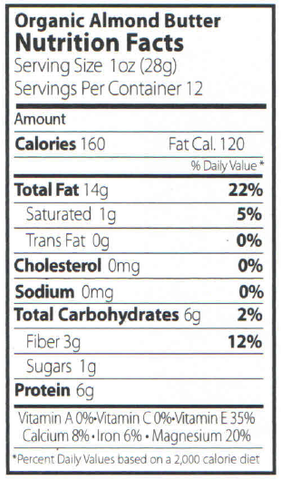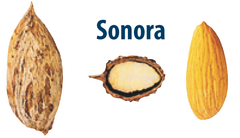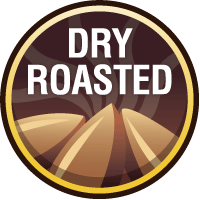Maisie Jane’s Nut Butter: A Healthy Alternative That’s Nuthin’ But Nuts
 Everyone wants to think they’re feeding themselves and their family healthy, quality ingredients. But we’re all faced with so many choices, how many of us actually take the time to read the nutritional label and know just what exactly we’re putting in our bodies? Maisie Jane’s Nut butters provide a healthy alternative to commercial products that tastes great too. If this is something you’re looking for, you’ve found the right resource to learn about Maisie Jane’s Nut Butters: why people are going nuts about them, how to use them, and the process we use to provide you a high-quality product.
Everyone wants to think they’re feeding themselves and their family healthy, quality ingredients. But we’re all faced with so many choices, how many of us actually take the time to read the nutritional label and know just what exactly we’re putting in our bodies? Maisie Jane’s Nut butters provide a healthy alternative to commercial products that tastes great too. If this is something you’re looking for, you’ve found the right resource to learn about Maisie Jane’s Nut Butters: why people are going nuts about them, how to use them, and the process we use to provide you a high-quality product.
Why go nuts about nut butters?
When walking down the aisles of your grocery store, do you find yourself aimlessly staring at the plethora of options before you? It can be overwhelming and end up turning you into an unsatisfied shopper, frustrated with the taste and quality of the products you’re finding on the shelves – You’re looking for healthier options, that are clean and natural.
Let’s face it – maybe you’re an avid peanut butter lover, but it’s not doing your waste-line any favors or helping you reach your health goals, so you’re looking for an alternative that still satisfies your craving – Almond Butter can do anything peanut butter can do!
Some people are forced to be picky because they have allergies to certain nuts, by-products, or additives and can’t find products that they can trust to not make them sick.
Maisie Jane’s nut butters are safe, clean and natural, so you know exactly what you’re putting in your body.
There are a variety of reasons to choose Maisie Jane’s nut butters instead of other commercial alternatives, but the most important thing that everyone can appreciate is that our nut butters stand out for what we don’t put in them.
That’s right!
- NO added salt
- NO added oils
- NO added sugar
- NO preservatives
- NON-GMO verified
Just 100% pure, dry-roasted nuts.
You might be wondering why dry-roasted matters.
Most commercially available value-added nuts are processed using various types of vegetable oils – canola, safflower, sunflower, etc. This creates a scenario where the nuts being used may be less than fresh and the oil may be sub-par. Oil can mask the flavor profiles (good or bad) of nuts and this can result in an inferior final product.
This is probably a good time to mention Steam Pasteurization too.
Pasteurization is required by the USDA and is important because it’s essentially cleansing or washing the almonds with steam to avoid outbreaks like salmonella. Most commercially available conventional almonds are pasteurized using Propylene Oxide gas fumigation, while steam pasteurizing is most often reserved for organic almonds. Maisie Jane’s chooses to use the potentially safer steam method on all of its almonds whether organic or conventional.
Are Nut Butters All They’re Cracked Up to Be?
Yes! Nut butters taste delicious, providing a smooth, creamy consistency without being too grainy and offering a robust nutty flavor. They are also good for you! We believe in knowing your food, knowing the process it goes through from farm to table and knowing how to use it.
Know your food
The proof is in the pudding – or should we say nut butter! Take a look at a sample from our Organic Almond Butter nutrition labels:


See? Nuthin’ but nuts! If you buy anywhere else, you’ll find sugars, oils, and ingredients you can’t pronounce. Our nut butters are all natural, with a variety of flavors to choose from.
Have Your Nut Butter and Eat it Too
Almond Butter
 |
Maisie Jane’s Almond Butter is a healthy and tasty alternative to peanut butter. It has no cholesterol, has fewer calories than peanut butter, is made from 100% dry roasted almonds and absolutely no additional ingredients. It’s naturally gluten free, wheat free, vegan, sugar free, and Kosher certified. It’s also made in a plant that does not process peanuts. It’s available in crunchy or smooth and both types are offered as an organic option as well. Taste and See: make an Almond Butter and jelly sandwich, spread it on sliced apples, or bake some yummy Almond Butter cookies. |
It’s one of our most popular products! We hand select the best almond varieties and focus on using the Nonpareil Almond, a superior type that can be used just about anywhere. We always use the freshest crop available. This means that we only produce what’s on order, so you’re guaranteed freshness – even when you order online and have it shipped right to your doorstep.
Need some inspiration? Get 6 Amazing Almond Butter Recipes straight from Maisie Jane's Kitchen! Click Here!
Creamy Cashew Butter
 |
The only ingredient you’ll find in our Cashew Butter is 100% dry-roasted cashews. There are no additives, it’s naturally gluten free, wheat free, vegan, sugar free, and Kosher certified. It’s also made in a plant that does not process peanuts and has a smooth texture and naturally sweet flavor. Taste and See: spread on toast, apple or pear slices or a filling for pitted dates |
Chocolate Hazelnut Butter
 |
Maisie Jane’s Chocolate Hazelnut Butter was created with having the ‘hazelnut’ shine. It’s not overly sweet because it contains far less sugar than the competing brands – dry-roasted hazelnuts are the number one ingredient. We also don’t add any emulsifiers or preservatives. Taste and See: Try it as a pretzel dip, topping for ice cream, fruit, waffles, and pancakes |
In a Nutshell
Maisie Jane’s Nut Butters are safe, healthy, and tasty alternatives you can trust because:
They contain:
- NO added salt
- NO added oils
- No added sugar
- NO preservatives
- NON-GMO verified
They are naturally:
- Gluten free
- Wheat free
- Sugar free
- Vegan
- Kosher Certified
- 100% dry-roasted
Are great for:
- People concerned with what’s in their food
- Allergy sufferers
- Recipes
- Baking
- Snacks
- Treats
- Everyone!
We understand the entire business and quality customer service is important to us; we have relationships with all the hands involved in the process – from the growers to the manufacturers, in-house distributors to large scales distributors so you are ensured quality products.
We grow, process, pasteurize, package and sell our nut butters – fresh from our family farm directly to you. Taste and see for yourself by ordering online here.
5 Common California Almond Varieties
All California almonds aren't created equal. Each type is highly versatile and available in numerous varieties used to create quality products your taste buds will love. Each variety has its own characteristics that help determine the best uses for them.
Since Maisie Jane is a fourth generation almond grower, and we farm our own almonds, we have added knowledge on these different varieties and have perfected identifying which varieties work for each of our products.
Get the "hull" story about almond types and varieties, as well as their forms and characteristics. "Shell" we begin?
Almond Anatomy
 *Infographic Source: Almond Board of California
*Infographic Source: Almond Board of California
Mission Type
Mission type almonds have hard shells and their nuts are small, wide and often plump. The nut is darker than nonpareil and wrinkled which allows salt and flavoring adherence. Not generally blanched.
California Type
Blanchable varieties used primarily in manufacturing. Wide-range of shell hardness, nut shape, and skin color. Versatile.
Common Varieties of Almonds
 Used anywhere. An attractive appearance and strong almond profile is important. A thin outer shell and smooth nut permit easy, blemish-free processing. Medium flat nut with light color and smooth surface. Maisie Jane’s products focus on nonpareil.
Used anywhere. An attractive appearance and strong almond profile is important. A thin outer shell and smooth nut permit easy, blemish-free processing. Medium flat nut with light color and smooth surface. Maisie Jane’s products focus on nonpareil.
 Though technically a California type, it is popular enough to be classified separately. A soft shell variety used in blanching and roasting. Often substituted for nonpareils.
Though technically a California type, it is popular enough to be classified separately. A soft shell variety used in blanching and roasting. Often substituted for nonpareils.
 A Mission Type. Semi-hard shell with a light color and smooth surface. The nut is small, short, plump with a wrinkled surface.
A Mission Type. Semi-hard shell with a light color and smooth surface. The nut is small, short, plump with a wrinkled surface.
 A California Type. Hard shell with light color, smooth surface. The nut is medium size with a wide shape and a fairly wrinkled surface.
A California Type. Hard shell with light color, smooth surface. The nut is medium size with a wide shape and a fairly wrinkled surface.
 A California type with a paper thin shell with dark brown color and rough surface. Nut is large, long, narrow with light color and smooth surface.
A California type with a paper thin shell with dark brown color and rough surface. Nut is large, long, narrow with light color and smooth surface.
Unlike some processors, we hand select the best variety of almonds for every single product we make, assuring the best quality and best-tasting almond products across the board.
Knowing the different types and varieties of almonds can help add flavor to your favorite recipe or serve up a healthy snack. Remember, an almond is not just an almond.
Discover the different ways Maisie Jane's uses almonds here.
Learn How Water-Wise Family Farming Produces More Crop Per Drop
 Saving water is always in the forefront of our minds. The topic has been getting a lot more focus in the midst of California's drought. We believe in doing our part to save our most valuable and natural resource by practicing holistic land management and investing in new technological approaches. Maisie Jane's water-wise practices will use 22% less water.
Saving water is always in the forefront of our minds. The topic has been getting a lot more focus in the midst of California's drought. We believe in doing our part to save our most valuable and natural resource by practicing holistic land management and investing in new technological approaches. Maisie Jane's water-wise practices will use 22% less water.
Maisie Jane’s works hard to promote Small Family Farming as sustainable for the earth and future generations by using less:
Less Water Use = Healthier Farmland
Solar Powered Pumps
- Solar power runs ag well pumps for our orchards and other small farm orchards we purchase
- Solar production monitoring system sends information to a phone app in real time
- Solar production power = less carbon footprint
Smart Well Motors
- Variable-speed drives on our well motors pull only the groundwater needed = less water pumped
- Automation of the water meter and timer working together to control our irrigation = less labor costs
Water Monitoring Probes
- Ground monitoring probes located throughout our orchards monitor soil moisture, sending information via phone, allowing us to adjust the moisture in the soil anywhere, at any time = less management time
- Water monitoring ensures that only the amount of water needed is delivered = less water waste
Water-wise Distribution
- Micro-irrigation, distributed via underground drip lines deliver water directly to the tree root system = less water needed
- Underground drip lines deliver water very slowly = less water lost to evaporation, runoff, and wind
- Drip irrigation is more than 90 percent water efficient in orchards vs. sprinklers (data: AB1881 using the California Model Water Ordinance)
- We use soil maps in designing irrigation systems to best match the soil characteristics of our orchards = less puddling and standing water
Why Less is Best
- Less weeds and grass mean less ground pests = less pest management
- Less weeds and grass mean less grass chopping = less tractor fuel
- Less surface water accumulation = less vegetation management
Facts about California Almonds and Water
Measuring up the water use with water being one of the most precious resources in Californian, people are talking more than ever about how to be more efficient with its use.
Unfortunately, almonds have become targeted in an alarming misconception born of these discussions; growing almonds uses 10% of California’s water.
 That’s far from the truth. It’s actually only 9% of the state’s managed agricultural water, as shown in the diagram on the right.
That’s far from the truth. It’s actually only 9% of the state’s managed agricultural water, as shown in the diagram on the right.
Although almonds occupy 13% of California’s irrigated farmland, they use only 9% of California’s agricultural (not total) water, less than their proportionate share.
Actually, almonds are not an especially “thirsty” crop. Almond trees use roughly the same amount of water as all other California fruit and nut trees.
California’s Mediterranean climate, with its cool wet winters and hot dry summers, offers ideal growing conditions for many diverse crops. California’s top ten crops in acreage are hay, almonds, grapes, wheat, corn, rice, walnuts, cotton, tomatoes and pistachios. And they all need water to grow.
The water almond trees use provides more than just almonds. Almond by-products don’t go to waste. The fuzzy green outer hulls feed dairy cows, while the harder inside shells are used for energy production through cogeneration and as livestock bedding.
Almond firewood is also in high demand.
An ideal climate, combined with rich soil, water infrastructure, innovative technology, and research, makes California the most productive almond-growing region in the world.
California produces 100% of the U.S. domestic supply of almonds and generates more than 100,000 California jobs.
For more than 100 years, Californians have been developing water infrastructure to effectively capture and transport surface water for use throughout the year and to store for dry years.
While a majority of California’s precipitation falls in the north of the state, it is moved through a network of canals and aqueducts to urban population centers and agricultural land.
All Californians, not just those in agriculture, rely on water captured and stored during wet winter months to access in dry summer months.
Despite population growth and decreased acreage dedicated to agriculture, the production of California agriculture has continually increased.
Bottom line, California farmers will continue to evolve, innovate and regulate their crops, to bring more food, grown with less water, to your table.
And that’s worth talking about!



